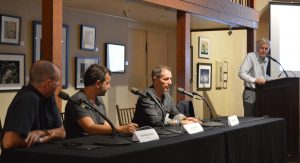Industry titans debate future of digital music
IN THIS ARTICLE
- Latest news Topic
- Philip Joens Author
By Philip Joens Wednesday, September 16th, 2015

John MacFarlane and Tom Conrad listen to Marc Geiger make a point at a panel discussion in Santa Barbara Sept. 16 on the future of digital music as MIT board member Bob Johnson looks on. Photo by Philip Joens/ Pacific Coast Business Times.
Three titans of the music industry had mixed views of the future of digital music and artists’ ability to profit from it during a panel discussion in Santa Barbara Wednesday evening.
The MIT Enterprise Forum of the Central Coast featured Tom Conrad, co-founder and retired chief technology officer of Pandora; Marc Geiger, head of the music division of entertainment giant William Morris Endeavour; and John MacFarlane, co-founder of Santa Barbara-based Sonos.
Conrad and Geiger are a little less optimistic about the future of the industry than MacFarlane.
Conrad said there is not enough money in the music ecosystem and there never has been for all artists to make it.
He said artists will always be underpaid unless consumers can be convinced to spend more money on music.
All three panel members are longtime friends, and argued furiously with each other during a question and answer portion of the event after each gave an individual presentation.
“The bottom line is, we’re in a time when there’s a lot of players,” Geiger said.
Conrad said that before the digital music age, music consumers generally only spent about $30 to $50 on music per year. Now consumers are being asked to pay $10 per month for Internet streaming subscriptions, Conrad said, and that is too expensive for many.
Geiger said that today’s artists have to create more content, faster than they did in the past. Artists also have to market themselves instead of outsourcing marketing to publicists because fans want authenticity when they interact with an artist.
They also have to market themselves on 20 different websites and social media platforms that have 20 different rhythms, Geiger said.
“Artists are not desktop publishers. They don’t understand how to do that,” Geiger said. “So all of a sudden, you have to be a major publisher and an artist, and you have to be authentic, so you can’t give it to your record label or your marketer to do. So artists are really challenged with learning this stuff.”
MacFarlane sounded a more positive note.
He said “the industry (is) going through a big change. There are more people listening to music all over the Earth than ever before. It’s a creative process. It’s just how you connect those two that is being redefined.”












